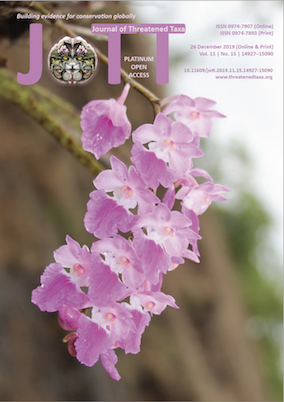Growth rate of captive Gharials Gavialis gangeticus (Gmelin, 1789) (Reptilia: Crocodylia: Gavialidae) in Chitwan National Park, Nepal
DOI:
https://doi.org/10.11609/jott.5491.11.15.14998-15003Keywords:
Captive breeding, Feeding, Growth rate, Hatchlings, Narayani River, Rapti River, Total lengthAbstract
Gharials Gavialis gangeticus have been reared in ex situ facilities in the Gharial Conservation and Breeding Center (GCBC) in Chitwan National Park of Nepal since the 1980s. There remains a paucity of detailed information concerning their growth rates, particularly with respect to season. We randomly selected 20 gharials (45 months old) in the GCBC, tagged them, and recorded total length (TL) and weight over three warm (April–September) and two cold (October–March) seasons between 01 April 2013 and 30 September 2015. We also recorded amounts of fish consumed by these gharials every month over the 30-month period. On average per season, the gharials grew by 9.48±3.63 cm (1.58cm/month) in length and gained 2.61±1.14 kg (0.43kg/month). Growth rates were significantly higher during warm seasons. The highest increase in both length (mean= 21.2±8.61 cm) and weight (mean =5.59±2.12 kg) occurred during the first warm season (April 2013–September 2013) of the study, and annual growth rate was also highest during the first year. Our data indicated strong correlation between mean length and body weight. A total of 2,103.9kg fish was consumed by 20 gharials over 30 months, for a mean consumption of 3.5kg fish per individual per month. Mean fish consumption was also significantly higher during warm (96.99±37.35 kg) versus cold (29.83±17.09 kg) seasons. Survival rate was 100%. Our findings establish baseline data for growth and feeding rates of captive gharials that will be useful in making management decisions in captive breeding and rearing facilities.
References
Balaguera-Reina, S. A., M. Venegas-Anaya, O.I. Sanjur, H.A. Lessios & L.D. Densmore (2015). Reproductive ecology and hatchling growth rates of the American Crocodile (Crocodylus acutus) on Coiba Island, Panama. South American Journal of Herpetology 10: 10–23.
Ballouard, J.M., P. Priol, J. Oison, A. Ciliberti & A. Cadi (2010). Does reintroduction stabilize the population of the critically endangered Gharial (Gavialis gangeticus) in Chitwan National Park, Nepal? Aquatic Conservation: Marine and Freshwater Ecosystems 20: 756–761.
Barrios-Quiroz, G., G. Casas-Andreu & A.H. Escobedo-Galván (2012). Sexual size dimorphism and allometric growth of Morelet’s crocodiles in captivity. Zoological Science 29(3): 198–204. https://doi.org/10.2108/zsj.29.198
Fellows, I. (2012). Deducer: A Data Analysis GUI for R. Journal of Statistical Software 49(8): 1-15. http://www.jstatsoft.org/v49/i08/
Gorzula, S. & A.E. Seijas (1989). The Common Caiman, pp. 44–61. In: Crocodiles: their ecology, management and the conservation. IUCN, Gland, Switzerland, 308pp.
Joanen, T. & L. McNease (1987). Alligator farming research in Louisiana, USA, pp. 329–340. In: Webb G.J.W., S.C. Manolis & P.J. Whitehead (eds.). Wildlife Management: Crocodiles and Alligators. Surrey Beatty & Sons, Sydney, Australia, 552pp.
Khadka, B.B. (2010). Gharial hatching status in 2010, Chitwan National Park, Nepal. Crocodile Specialist Group Newsletter 29(3): 16–17.
Khadka, B.B. (2013). Effect of weather on hatching success of Gharial in Chitwan National Park. Crocodile Specialist Group Newsletter 32(4): 5–7.
Lang, J.W., S. Chowfin & J.P. Ross (2019). Gavialis gangeticus. The IUCN Red List of Threatened Species 2019: e.T8966A3148543; https://doi.org/10.2305/IUCN.UK.2019-1.RLTS.T8966A3148543.en
Maskey, T.M. (1989). Movement and survival of captive-reared gharials, Gavialis gangeticus, in the Narayani river, Nepal. Ph.D. Dissertation, University of Florida, USA, xiv+187pp.
R Core Team (2018). R: A language and environment for statistical computing. R Foundation for Statistical Computing, Vienna, Austria.
Saalfeld, D.T., K.K. Webb, W.C. Conway, G.E. Calkins & J.P. Duguay (2008). Growth and Condition of American Alligators (Alligator mississippiensis) in an Inland Wetland of East Texas. Southeastern Naturalist 7(3): 541–550. https://doi.org/10.1656/1528-7092-7.3.541
Stevenson, C. & R. Whitaker (2010). Indian Gharial Gavialis gangeticus, pp. 139–143. In: Manolis, S.C. & C. Stevenson (eds). Crocodiles: Status Survey and Conservation Action Plan. Crocodile Specialist Group, Australia, 143pp.
Thorbjarnarson, J. B. (1988). The status and ecology of the American crocodile in Haiti. Bulletin of the Florida State Museum, Biological Sciences 33: 1–86.
Webb, G.J.W., H. Messel, J. Crawford & M.J. Yerbury (1978). Growth rates of Crocodylus porosus (Reptilia: Crocodilia) from Arnhem Land, Northern Australia. Australian Wildlife Research 5: 385–399. https://dx.doi.org/10.1071/WR9780385
Published
Issue
Section
License
Authors own the copyright to the articles published in JoTT. This is indicated explicitly in each publication. The authors grant permission to the publisher Wildlife Information Liaison Development (WILD) Society to publish the article in the Journal of Threatened Taxa. The authors recognize WILD as the original publisher, and to sell hard copies of the Journal and article to any buyer. JoTT is registered under the Creative Commons Attribution 4.0 International License (CC BY), which allows authors to retain copyright ownership. Under this license the authors allow anyone to download, cite, use the data, modify, reprint, copy and distribute provided the authors and source of publication are credited through appropriate citations (e.g., Son et al. (2016). Bats (Mammalia: Chiroptera) of the southeastern Truong Son Mountains, Quang Ngai Province, Vietnam. Journal of Threatened Taxa 8(7): 8953–8969. https://doi.org/10.11609/jott.2785.8.7.8953-8969). Users of the data do not require specific permission from the authors or the publisher.





